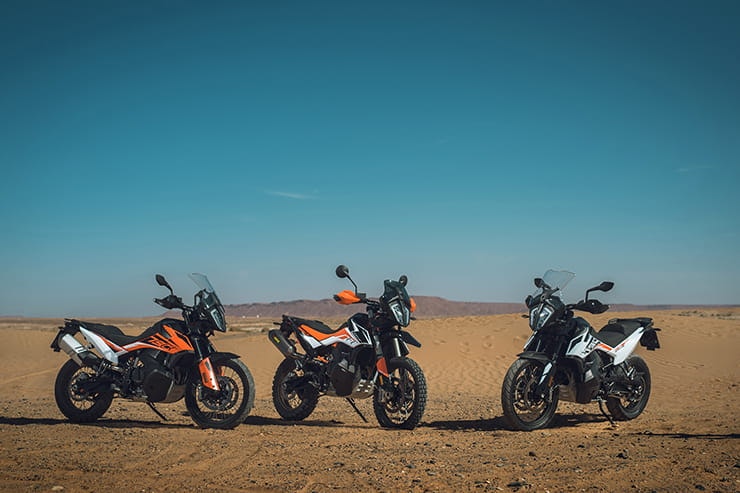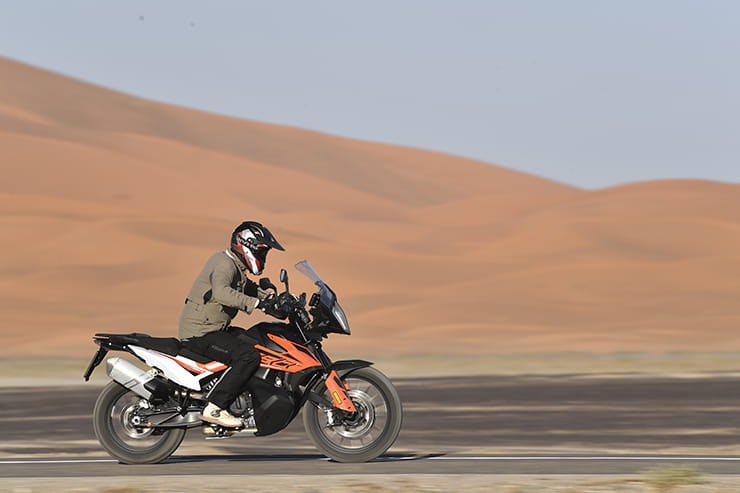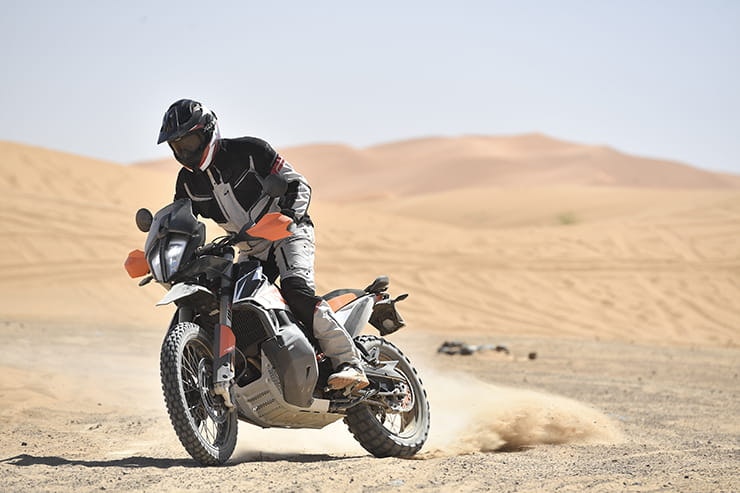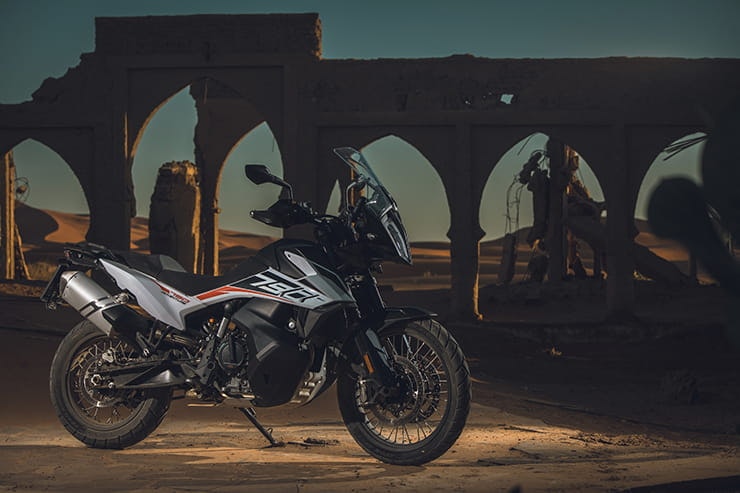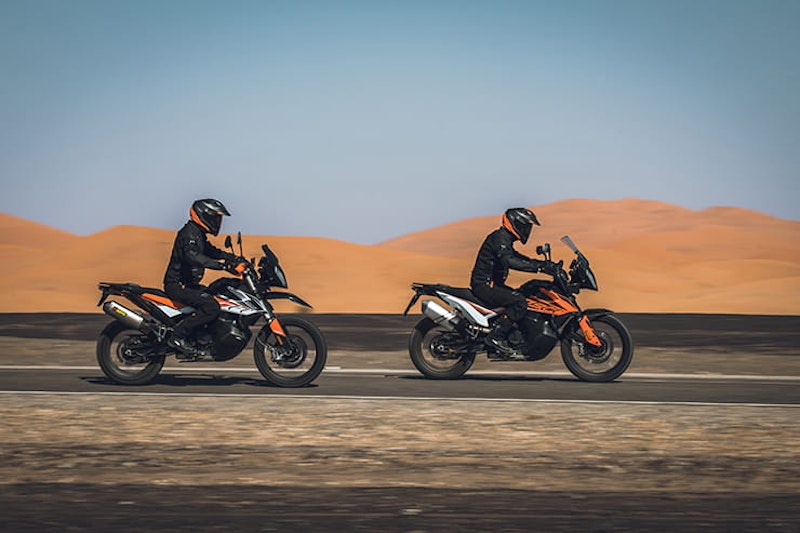KTM 790 Adventure & 790 Adventure R (2019) | REVIEW
BikeSocial Road Tester
11.03.2019
Not everyone wants the expense and bulk of a full-size, litre-plus, 130bhp flagship adventure bike in their life, so it’s up to mid-sized adventure machines like BMW’s F850 GS and GS Adventure, Triumph’s Tiger 800 XCa, Honda’s Africa Twin, Africa Twin Adventure Sports and soon, Yamaha’s Ténéré 700, to deliver authentic off-road chops as well as all-day comfort and convenience.
They all have commonalities: a 21in front wheel is the default for genuine off-road potential. They all make around 94bhp or less, and are eligible for A2-licence friendly 47bhp restriction. And they all, £8400 Yamaha aside, cost between £11,000 and £12,500, depending on spec, electronic sophistication and selected optional extras – of which each manufacturer has many.
As a company with modest off-road expertise (a small matter of 18 consecutive Dakar rally wins, for a start), KTM are having a second go at the mid-sized adventure class with the new dual-purpose 790 Adventure and more off-road oriented Adventure R. They previously dabbled with the decidedly non-middleweight 94bhp 1050 Adventure, which didn’t exactly fly out of showrooms. But the new 790s, based around an adapted version of the outstanding 790 Duke parallel twin, represent a more compact and manageable grab for a slice of the middleweight adventure pie. Like their rivals, the 790s are off-road ready with 21in front wheels, A2-compliant with 94bhp, bursting with electronic options as standard, and with even more as optional accessories.
If the 790 Duke is anything to go by, the 790 Adventures will be good. But will they be good at the right things, and good enough to pinch sales from the Africa Twin and F850GS? BikeSocial is at the launch in a dry, dusty Moroccan desert to find out.
What’s the difference between the 790 Adventure and Adventure R?
The 790 Adventure is the standard, more road orientated bike; the R is a more off-road biased machine. The two are almost identical, and the differences are interchangeable so you can spec either bike with different parts from the other. Both also share exactly the same engine and performance, same gearing, frame, wheels, tank, clocks, brakes, swingarm, transmission and electronics. The differences are limited to:
• suspension – the Adventure gets non-adjustable WP forks and shock; the R gets a more advanced, fully-adjustable WP set-up with 100mm more travel front and rear
• front mudguard – the Adventure’s hugs the wheel; the R’s is a high, off-road style
• screen – the Adventure’s is two-way adjustable (undo a bolt) road screen and the R’s is a shorty, off-road style (but still adjustable)
• seat – the Adventure has a two-piece seat with two-way 830mm/850mm adjustable height (on standard, Adventure-spec suspension), and the R has a non-adjustable single seat with 880mm ride height (with long-travel suspension)
• Rally mode – the R gets a Rally rider mode as standard, giving the most direct throttle response and full power, along with the option to scroll through traction control levels using the up and down buttons on the left bar cluster – which means, in practice, you can instantly tailor rear wheel spin to suit something like riding in sand, with little spin control, or lots of spin control if you’re riding on tarmac with knobbly tyres and you want to preserve them
• colours – the Adventure comes in white/black and orange/white/black; the R in orange/black/white with orange frame
Apart from these features, the Adventure and Adventure R are identical.
VIDEO review: KTM's 790 Adventure / Adventure R
Motorcycle road testing legend, Simon Hargreaves gets out his Go Pro for our benefit and reports from the press launch of the two new KTM's
2019 KTM 790 Adventure price, PCP deal, and availability
In dealers mid-March
OTR: £11,099.00
Colours: orange or white
KTM PCP deal
2019 KTM 790 Adventure R price, PCP deal, and availability
In dealers mid-March
OTR: £11,999.00
Colours: orange/white
KTM PCP deal
Power and torque (claimed, both models)
94bhp @ 8000rpm
66 lb.ft @ 6600rpm
Engine, gearbox and exhaust
Parallel twins don’t come much more lively than the 105bhp, 799cc lump in KTM’s 790 Duke streetbike. Literally; it’s the most powerful parallel twin in production, and it behaves like it knows it is. It’s a busy, fizzing, pumping, charging unit, always up for a good time, even if you aren’t. It also has a noticeable two-stage kick to its power delivery: the torque curve peaks at 6500rpm, dips, then goes again for another peak at 8000rpm. When you ride the 790 Duke, it’s like having a naughty little extra bonus at the top end.
The 790 Adventure (and Adventure R) have identical engines, borrowed from the 790 Duke and sharing the same cases, crank, rods, pistons and throttle bodies as the streetbike. According to KTM, the Adventure motors are retuned for a more midrange-rich performance, as would befit an off-road-cum-adventure bike – you want it grunty, not revvy. And instead of making 105bhp at 9000rpm, the Adventure and Adventure R make an A2 licence-compliant 94bhp at 8000rpm (KTM claim 95bhp, but are using Austrian poetic licence to round up an actual 93.8bhp – and it means the Adventure could, in theory, be restricted down to 47bhp. Although I wouldn’t blame you if you somehow forgot, in all the excitement).
To lose the 11bhp and 1000rpm from the 790 Duke motor, KTM have manipulated the parallel twin’s torque curve and squeezed it down towards the lower end of the rev range by using milder cam timing with appropriate fuelling changes. So the total area under the torque curve – the ‘quantity’ of torque – remains the same as the 790 Duke, but biased towards lower revs. It means the Adventure’s torque output from tickover to 7500rpm is increased over the Duke, peak torque of 66 lb.ft (2 lb.ft more than the Duke) drops 1400rpm lower in the revs to 6600rpm, but it’s all at the expense of robbing the motor’s torque above 7500rpm – in fact the Adventure’s torque curve starts dropping off at just over 6000rpm, which is what caps its peak power figure.
And it’s no surprise to discover, on a fairly brief road ride, the 790 Adventure’s motor feels pretty close in character to the 790 Duke’s, if down on top end pizazz. It’s got the same eager, raucous chatter, with its 285° firing interval (designed to imitate KTM’s 75° V-twins) delivering an off-beat, cantering heartbeat. The ride-by-wire power delivery is loose and free-spinning; it’s a motor that strains at the throttle’s leash, wanting to slip its collar and go charging off in a rev-happy lather like a dog chasing a tennis ball. The typically KTM-style raw, connected feel is present and correct – it’s a directness that appears to be unfiltered by electrons, wires, servo motors and fuelling table algorithms, and it’s a different way of thinking compared to the comparatively fluffy bunnies inside the parallel twins in the Africa Twin and BMW F850GS. In terms of sheer vivacity, the Adventure’s motor makes its rivals’ engines feel a bit tame and mild-tempered. We’ve even got V-twin-esque vibes, smoothed by twin balancers (one in the cylinder head as per the 790 Duke, which is unconventional) – but they’re the good kind of vibes; too low frequency to blur senses or numb fingers, it’s a sort of funky lightweight chundering.
Of course, some of us might not appreciate the KTM’s all-out style, because we aren’t all ready to race – some of us are barely ready for breakfast. When you’re banging out the last 100 miles of a 500-mile motorway ride, you might prefer a bike that makes as few demands on your fading energy as possible and conveys you to your bedside chamber pot with minimum fuss. And minimum fuss is notable by its absence from KTM’s DNA. Maximum fuss is very much what they’re about.
So from the moment you feed out the light clutch and the motor picks up and starts to drive forward, it’s obvious the 790 Adventure just wants to crack on with it. The first three gears disappear in a wa-hey of go-faster; swapping between the top three cogs is where the most use lies on the road. 75mph in top gear is 5000rpm and 88mph is 6000rpm; that’s also where the torque and power curves are steepest so roll-on acceleration is wonderful; drop down a gear to fifth and the Adventure really picks up and takes off with a muted thrapping (the Adventure R comes with a fruitier Akrapovic slip-on; an £831 accessory).
Granted, the Adventure is missing the 790 Duke’s extra chunk of top end power; once you get past 6500rpm it’s downhill in terms of piling on speed – but this is at the extreme end of road riding. Even a pillion won’t tax the 790 Adventure’s motor too much; after all, KTM 790 Adventure-riding Joe Pichler, a kind of Austrian Nick Sanders with better hair, rode a 790 Adventure two-up with his missus and luggage, many thousands of miles across Africa. Squires café on Sunday will be no problem.
The launch Adventure and Adventure R both come loaded with optional up and down quickshifter – a £334 accessory item. It works perfectly to deliver seamless, uninterrupted acceleration and super-rapid downshifts. There’s no over-sensitivity or cutting ignition with a wayward off-road boot, but neither is the change as leisurely as BMW’s shift assist. It’s especially useful off-road and standing on the pegs – when dabbing up and down on the lever without using the clutch is a bonus.
2019 KTM 790 Adventure Economy
A big 790 Adventure talking point is its throw over fuel tank, dangling each side of the motor like a pair of pendulous moobs (and I should know). Now, on one hand you have to credit KTM; the engine is not a thirsty unit – on the launch it varies between 53mpg and 62mpg which could, on a 20-litre tank, mean between 200 to 250 miles between stops. That’s good going.
But to fit a 20-litre tank on a bike with lots of wheel travel, good ground clearance, a compact motor, a cantilever shock and a narrow stand-over profile, you’re running out of room. Honda and BMW manage it on the Africa Twin Adventure Sports and F850GS Adventure by going higher and wider; KTM have gone lower and wider instead – following the concept of the Dakar rally bikes by draping the tank over the top of the engine, leaving plenty of room between the rider and the headstock, and significantly lowering the 790 Adventure’s centre of gravity, which leads us to...
Suspension, chassis and weight
According to no lesser an authority than KTM Dakar winner Sam ‘not from Sunderland’ Sunderland, lowering the centre of gravity of a rally bike is a good thing because it adds stability and, in the case of his rally-spec 450, a pair of low-slung tanks at the back of the bike (as well as a pair at the front) aids traction on sandy-type sand. Another KTM riding ambassador, Chris Birch, also points out the droopy fuel tank minimises the changing effects of a full v empty tank on the bike’s handling. At least, that’s off-road.
Obviously they very clearly they know what they’re talking about. And here’s a shot of Chris showing he knows what he’s talking about.
But I’m not sure how much time Sam and Chris spend riding at full tilt on the road, where a low centre of gravity tends to favour a chassis dynamic that rolls steadily into corners rather than dives into them; it’s how sports tourers and tourers handle (think of bikes like the Pan European, ZZ-R1100, FJR1300 etc). This in itself isn’t a problem – and the 790 Adventure certainly doesn’t handle like a Pan. It’s light, agile, and still feisty enough to warrant a steering damper (which the the 790 Duke, with a conventionally positioned tank, also has) – but it’s definitely more restrained than the beserko 790 Duke. It’s 15kg heavier than the naked bike, what with its wire spoke wheels and extra tank heft, at 189kg dry – probably around 209kg fuelled, oiled and ready to roll. That’s still a sack of spuds lighter than an Africa Twin, Tiger 800 XCa or a BMW F850 GS, and it feels it.
But you have to wonder what the effect of that low-down tank will be on front tyre grip when the 790 is braked in the wet, say, with a bit of lean on, and physics tries to push the front wheel sideways and forwards as much as pushing it down into the tarmac. A certain Mr F. Spencer (not Frank) had the same problem on his 1984 Honda NSR500, which carried its fuel under the engine; it would push rather than pin the front under braking, causing a slide or crash. Kawasaki ZZ-R1100s had the same kind of issue in the 1990s. And it if carrying fuel low is such a good idea, why hasn’t anyone else done it? Okay, maybe because it looks gopping.
But there’s no doubt the 790 Adventure has serious suspension. The Adventure’s standard 43mm WP APEX forks are non-adjustable, and the cantilever rear WP shock is preload only, but supply good ride quality and good control. The forks dive a bit too eagerly under the force of the Adventure’s brakes, but it’s easily mitigated by modulating lever pressure and getting used to it. It at least it demonstrates some braking force is travelling along the forks and into the tyre.
The Adventure R comes on superior suspension; it’s where the bulk of the difference in price between the two bikes goes. The forks are fully adjustable 48mm WP XPLOR, running an extra 40mm of wheel travel over the standard Adventure. A fully adjustable WP shock compliments the front end, and also adds 40mm of travel. Longer travel suspension is better equipped to cope with the suspension loading of off-road riding – rocks cause shocks.
Brakes, wheels and tyres
The Adventures share a twin 320mm disc and radial 4-pot caliper set-up; unusually, the 790 Duke road bike has smaller, 310mm discs (unusual because off road versions of streetbikes usually have reduced brake performance, because of skinnier front tyres and longer travel suspension). I wonder out loud if the Adventure bike gets bigger discs because one of the only criticisms of the streetbike is it’s a bit soft on the brakes. But no; the official reason for bigger discs is to get clearance on the wire-spoked wheels.
The Adventure comes on Avon Trailriders; the Adventure R on knobblier Continental TKC80s. The Avon work fairly well on dust and rocks; not sure how long it’d take to clog the tread on a muddy trail in the Peaks. TKC80s are well known and liked.
Ergonomics and comfort
Both Adventure and Adventure R share an adjustable riding position; the bars have six positions front to rear, giving 30mm of front-to-rear movement – and can, of course, also be rotated in the risers to a degree. But on their standard setting the riding position on the road is – after a brief ride – clearly very good. The standard two-piece seat is wide and firm, and the pegs are slightly rear-set but low enough for to uncramp aching knees (with the seat on its high, 850mm setting). It feels natural, slightly aggressive, and distinctly engaging. I could ride it a lot longer than the half hour blat we get on the launch (seat height is even more adjustable; KTM will supply a low seat option and lowering kit that takes the Adventure down to 800mm; it should accessible to anyone).
But not without earplugs. On its standard setting, the standard Adventure’s screen is loud and then some, with a lot of wind roar and a fair bit of buffeting getting to the rider’s head. Either the screen in its high position or the Adventure R’s shorty screen are better bets.
On the Adventure R, most of the launch is spent standing up; on the occasions I sit down, the slimmer, fixed height (880mm) single seat feels just as comfy as the standard bike.
Equipment
KTM are never shy of loading their bikes with tech, and the 790 Adventure has plenty. KTM’s lean angle-based traction control is present, along with cornering ABS. Rider modes allow customisation: modes include Street, Rain and Offroad, plus an extra Rally mode as standard on the R and an optional extra on the Adventure. Street is a normal throttle response and full power, Offroad is full power and smoother throttle response, Rain is 75% power and smoothest throttle. Rally mode is full power and a direct, almost linear throttle response – but none of them are snatchy and all are usable.
Along with changing power and throttle response, the rider modes also vary the level of traction control and ABS: Street has limited TC, Offroad has less TC because sometimes wheelpsin is needed off-road (and disables cornering detection and disable ABS at the rear), and Rain has maximum TC. Rally allows the level of TC to be dialled up or down according to the terrain, but also removes anti-wheelie.
A huge range of factory accessories include optional quickshifter, cruise control and heated grips – all three of which would be nice as standard.
2019 KTM 790 Adventure & Adventure R: VERDICT
KTM have built the most off-road capable middleweight adventure bike in the game – for their prices, both the standard Adventure and Adventure R are a level above the competition in terms of weight, standard equipment spec and off-road chops. It’s understandable and inevitable – KTM are about racing, and rally racing is massive part of what the company stands for. The launch is in Morocco, at a location KTM use for elite rally training, over challenging and unpredictable terrain, and with a 20/80 road/off-road riding split. That alone, and their ‘adventure harder’ slogan, shows clearly who they’re aiming the 790 Adventure at, and what it’s designed to do. They could’ve launched it with a 200-mile road ride and a bit of light messing about in the woods.
But it’s unclear how many aspiring rally winners there are in the UK (as opposed to enduro and trail riders, who better fit the off-road scene). And there’s even less scope for riding on sand. Many adventure bike owners are much more likely to want to hammer 300 miles up a motorway, then spend four days pinging along the NC500 in Scotlandshire. And for that, you’d rightly prefer a nice, soft, comfy, easy-going adventure bike, maybe not a pukka off-road machine.
So I suspect the KTM 790 Adventure, for all its dynamic excellence both on road and off, will have a tough time in British showrooms, simply because there aren’t many of the riders it’s aimed at. The Africa Twin is undeniably a prettier bike, with a softer and more accommodating long distance ride dynamic. The BMW F850 GS is also a more rounded and gentle machine, with its effortless technical excellence. And Triumph’s Tiger – even the XCa – has three cylinders and is so good on the road it’s lack of off-road skills are irrelevant.
And all three would, for a given level of rider ability, be less competent off road than either the Adventure or Adventure R.
Three things I love about the Adventure and Adventure R…
• engine performance – strong, willing, up for a laugh, always entertaining
• riding position – plugged-in, great seat, loads of legroom
• handling – agility, ride quality and chassis balance
Three things I don’t…
• looks – not a good-looking bike and the Africa Twin is prettier
• fuel tank – still not sure about its position
• off-road bias – more people would want just a bit more road focus more of the time
2019 KTM 790 Adventure and (Adventure R in brackets) Specs
